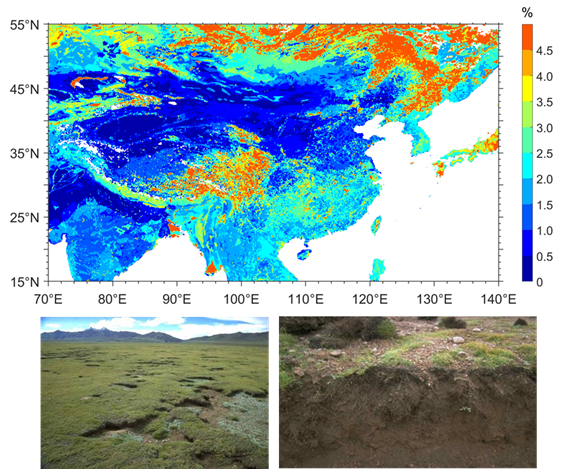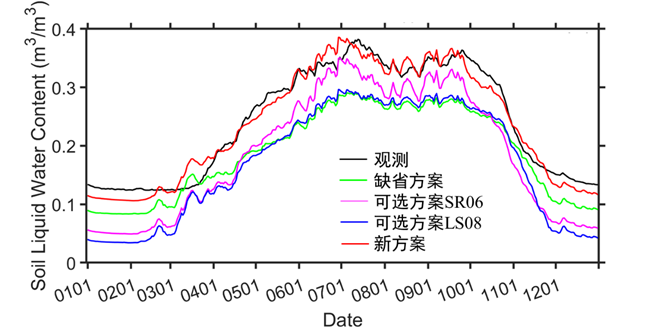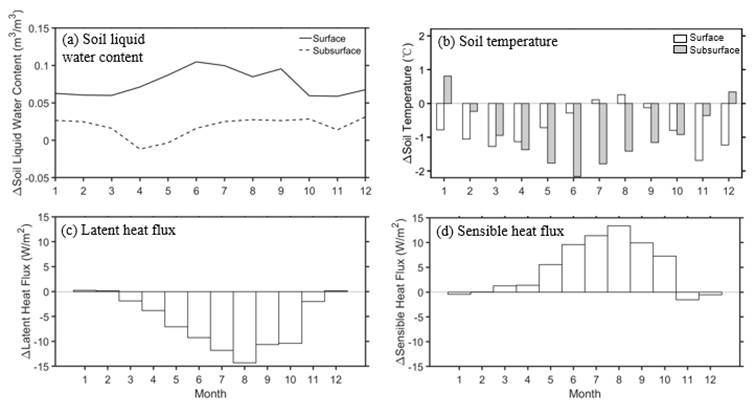In the central-eastern Tibetan Plateau (TP), there is abundant organic matter in topsoil, which has brought hydrothermal properties that general mineral soil does not have and arouse obvious vertical stratification of soil (Fig. 1). Hence, this needs to be properly described in land surface models. Limited soil parameterizations consider the impacts of soil organic matter (SOM), but they still show poor performance in simulating the soil hydrothermal processes in TP.

Fig. 1 The upper shows the SOM spatial distribution in TP; the lower shows the obvious vertical stratification of soil caused by high SOM content
To this end, the research group led by Professor Yang Kun from the Department of Earth System Science of Tsinghua University revealed the influence of organic matter on soil hydrothermal processes and surface energy budget in Tibetan Plateau, and improved the simulation of soil hydrothermal processes. The research results have been published in a paper titled “Influence of Organic Matter on Soil Hydrothermal Processes in the Tibetan Plateau: Observation and Parameterization” in the Journal of Hydrometeorology.
In this study, SOM hydraulic characteristics in Nagqu Area of the central TP were analyzed by measuring large sets of data such as soil texture, organic matter content, water-retention curve, saturated hydraulic conductivity and soil moisture/temperature. It is found that SOM water-retention rate in TP has been demonstrated to be much underestimated in previous studies, and SOM saturated hydraulic conductivity is overestimated. Accordingly, a new soil hydraulic parameterization scheme based on observations was incorporated into Noah-MP. The results of numerical experiment show that the new scheme obviously improves topsoil liquid water simulations at stations with high surface SOM content (Fig. 2). A further application with the revised Noah-MP indicates that in the warm season, SOM can increase soil water content due to its high water-retention rate (Fig. 3a), and reduce heat transfer due to its low thermal conductivity, which lowers subsurface soil temperature (Fig. 3b). Despite the soil water content increases, the faster increase of soil porosity can lower soil moisture, thus reducing evaporation (Fig. 3c) and enhancing sensible heat flux (Fig. 3d). In the cold season (January-April and November-December), soil water freezes and surface water-vapor exchange weakens. However, SOM lowers the thermal conductivity and reduces surface-subsurface heat exchange, and the topsoil temperature drops faster due to surface energy loss. It is worth noting that the process that vegetation root mucus affects soil hydrological properties and the related parameters were introduced in previous studies to better simulate the water content of high-SOM soil, which makes the model more complex. In contrast, the proposed parameterization scheme needs no change of model structure and no new parameters.

Fig. 2 Simulation Results of Liquid Water Content in High-SOM Topsoil by Using Existing Schemes (Default Model Scheme and Alternative Schemes SR06 and LS08) and New Scheme in Noah-MP

Fig. 3 Influence of Organic Matter on Soil Hydrothermal Processes and Surface Energy Budget. The differences in the average simulation results (2011—2017) of high-SOM soil (considering organic matter vs. not considering organic matter) show that organic matter (a) increases soil liquid water content, (b) lowers soil temperature, (c) weakens latent heat flux, and (d) enhances sensible heat flux.
Sun Jing, a doctoral student in the Department of Earth System Science of Tsinghua University, is the first author, and Professor Yang Kun from the Department of Earth System Science of Tsinghua University and Associate Researcher Chen Yingying from the Institute of Tibetan Plateau Research of Chinese Academy of Sciences are the joint corresponding author. The collaborators include Associate Professor Lu Hui from the Department of Earth System Science of Tsinghua University, Associate Professor Zhao Long from the School of Geographical Sciences of the Southwest University and Researcher Zheng Donghai from the Institute of Tibetan Plateau Research of Chinese Academy of Sciences. This study has received the support from the National Key R&D Program (No. 2018YFA0605400), the Basic Sciences Center of the National Natural Science Foundation of China (No. 41988101) and the General Project of the National Natural Science Foundation of China (No.41975125).
Paper details: Sun, J., Y. Chen, K. Yang, H. Lu, L. Zhao, and D. Zheng, 2021: Influence of organic matter on soil hydrothermal processes in the Tibetan Plateau: Observation and parameterization. J. Hydrometeor., 22(10), 2659-2674, doi: 10.1175/JHM-D-21-0059.1.
Paper link: https://journals.ametsoc.org/view/journals/hydr/aop/JHM-D-21-0059.1/JHM-D-21-0059.1.xml
Contributed by: Yang Kun & Sun Jing
Edited by: Wang Jiayin
Reviewed by: Wu Haiping